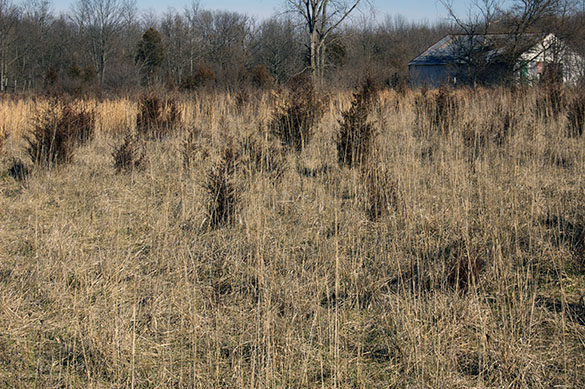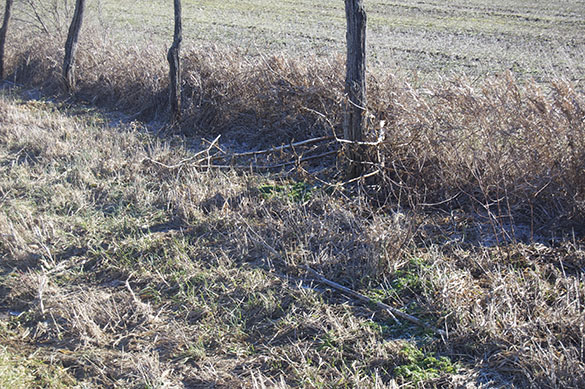I made a passing remark in my post last week that I feel my modeling has grown shallow as a result of being complacent with my skill level. After some serious thought and cleaning out a ton of clutter that no longer has any relevance to where I want to go with my modeling, I feel it’s time to focus on improving my skills by focusing more on projects that present greater challenges.
I thought I was doing a pretty good job with the scenery in this area, especially the groundcover. Quarter-inch scale demands something beyond a simple dusting of ground foam and a few clumps of something to represent bushes. That might work in the smaller scales but not for quarter-inch.
I’d become quite pleased with the sisal twine technique for wild grasses and, must admit to secretly feeling smug over the amount of work I put into the layout scenery so far. To date, I had placed a tree line flat on the backdrop and started filling in the groundcover with my usual methods. All was fine, until my copy of Gordon Gravett’s book on modeling grasslands, roads and water features arrived. I’m not ashamed to admit when I’m wrong and in this case, I learned that I don’t know the first thing about modeling wild grasses and other ground covers. Yes, his work is that good, and I was able to look at my own with more objective eyes, seeing much room for improvement.
Now mind you, I’m not saying that what I’ve done so far is bad or of no consequence. That’s going too far off the deep end. I’ve simply become more aware of what can be accomplished by someone more experienced and knowledgeable than I am, hence, I’m a student again. My techniques still have a valid place and have served well, but there are many techniques and materials available now, most of which I haven’t tried or had access to before. With some thoughtful experimentation, I can use them to enhance what I’ve built.
One of the take-away items from the book for me is his careful attention to the various textures found in the full-size world. This is something we gloss over in our haste to just get the job done. Grass in the wild doesn’t look anything like the manicured lawns of residential areas. Many commercial products, even static grass sheets, are just too uniform in nature to effectively represent the tall ragged nature of wild grasses (below).

This field will revert back to forest if left alone. The abundance of cedar saplings will eventually give way to hardwood species.
This is one of the areas of my scenery that needs improvement, as an over-reliance on a single technique and material tends to produce the same uniformity in outcome. In the photo above, you can see how the waist high grass dies off and will mat down over the winter. Below, this fence line shows a different impact where the frost killed grass is a mass of clumps with some green showing through, while the inaccessible areas of the ditch line are a tangle at the base of the fence. Do we even see these things until someone points them out?
 Someone reading this will wonder: why bother with such obscure details? It’s just scenery. It’s supposed to be model railroading, not model landscaping.
Someone reading this will wonder: why bother with such obscure details? It’s just scenery. It’s supposed to be model railroading, not model landscaping.
I answer that by noting there’s another principle to consider: That being one of consistency. When one or more modeled elements are grossly out of balance with the rest, the realism we’re trying so hard to achieve suffers greatly. When the trains are highly detailed and the scenery isn’t, the contrast between them will be jarring. Many modelers don’t understand this or simply don’t care enough to do anything about it. They simply spend their time wondering why things don’t look as realistic as they could or console themselves by thinking it doesn’t matter. It does matter.
I understand the arguments presented by those who have chosen a larger, more complex layout project. The key isn’t in hyper-detailing everything, it’s that one pay attention to creating a consistent level of detail across all aspects of any project, large or small. In my case, the modest nature of my layout makes a more detailed approach in all aspects possible, which is the perspective I naturally write from.
As this area progresses, I’ll be leaning heavily on Gordon’s work for inspiration and looking more closely at the landscape for ways to improve. The real lesson here is that you don’t need to completely scrap a layout in order to find new projects. An existing layout can be improved upon continuously.
Modelling Grassland and Landscape Detailing by Gordon Gravett
ISBN 978 1 908763 06 8
Wild Swan Publications Ltd.
1-3 Hagbourne Road, Didcot, Oxon, OX11 8DP
I purchased my copy from International Hobbies of Auburn California. It’s the simplest and fastest way to get a copy if you’re in the US. I have no connection with Wild Swan or International Hobbies beyond being a satisfied customer.
Regards,
Mike
Mike,
I think a key point this brings out, that I’m very aware of with a long commute by rail at this time of year, is that the landscape needs to be modelled to suit both a specific location and a specific time of year. In most of the UK the winter landscape is massively different from the early summer landscape.
Regards
James
Indeed! We fall far short with rendering both. Generic scenery has been the rule in the US hobby for decades, if not forever. I suspect it is similar in the UK and elsewhere.
Good observation James. Thanks.
Regards,
Mike
Hi Mike,
Like all forms of craft, and especially so with modelling, the learning process never ceases. For example, back in the 50’s and 60’s. the use of dye colored sawdust as a means of ground cover gave way to ground foam in the late 70’s to 80’s. Then in the 90’s, the application of various mixes and concoctions of real earth and sculptamold over a latex brown base gave way to static grass and teased silfor in the 21st century.
As a person involved in the craft, the new technology brings with it new ways of achieving the results we strive for, the new technology prompts use to use it in better ways to increase fidelity. However the underlying process is our ability to view and replicate what we see, and as you have so often written about, the details so regularly overlooked or unnoticed by the modeler become the limit in that endeavour.
So as you have noted, the oldest part of a layout could do with a “spruce up” by applying those new techniques and materials to lift the level of realism. That’s exactly why a model railroad is never really finished.. There is always something to improve on, rebuild or revitalize. Sometimes even the ides others provide can themselves be inspirational…
Scenery as a craft has no limits, it is “us” that have to overcome our myopic view and inability to search better alternatives and fear of re doing a scene because we make the excuses to justify our work, rather than look upon it as a challenge and opportunity to improve it.
Congratulations as always for pushing the boundaries… and having the courage to be self critical. Looking forward to your results.
Cheers,
Marz
Hi Marz,
Good to hear from you! I thought of you when the recent typhoon slammed through your part of the world.
Thanks for the comments. Yes, techniques evolve but our understanding of what we’re trying to model seems to remain stagnant for many. I guess it’s my art background, if something bothers me enough, I will make changes, even if it means a complete do-over from scratch. Sometimes there is just no other way to go forward. I had many compliments on the wooded hillside that used to occupy this area but it wasn’t right to my eyes and didn’t fit in with the developing scenes on both sides, so out it came.
From my own experience and from listening to others, we seem to have two reactions to frustration in this hobby: scrap an effort completely and start over from scratch or freeze up with indecision and learn to live with the frustration and resulting compromise. Perhaps a third is to consider everything carved in precious stone and untouchable as a result.
I’ve learned it’s simply a layout; world peace doesn’t hang in the balance if a thing needs changing.
Regards,
Mike
Hi Mike
I too have found Gordon’s book to be excellent. Although his and Maggies Pempoul layout is freelance it’s researched like a real location and is definately unique on the UK exhibition circuit. Both are more than happy to give thier time freely at exhibitions, if you ever come over to the uk it’s worth timing it with a show they are appearing at. There are often layouts that raise the bar but the first appearance of Pempoul was a bit of a game changer for some of us.
Going to your point, consistancy is everything. The stuff I do is considered (rightly or wrongly) as quite detailed my over-riding goal is for it all to go un-noticed. Much as things like street lights do in the real world. Consistancy is the key to this, nothing should scream out ‘look at me’.
Cheers
Jim
Hi Jim,
I’ve watched a few YouTube videos of Pempoul. It’s a fine layout.
I agree. So much of the outside world is just “there”, meaning we take it for granted and don’t even notice things until they break or something else unusual happens to grab our attention again. Like you, I feel a layout scene should convey a similar feeling, with the proper things in their proper place as we expect them to be.
Of course, most of us fall short of this objective by overemphasizing the trains or other aspects that catch our fancy. Of course, most overcrowd their layouts with far too much stuff. We also forget the power of color and contrast; light and shade as means of directing the eye. And, let’s not forget the power of emphasis to lead the eye both by what is emphasized and what isn’t.
There’s a whole new world waiting for modelers who take the time to understand such concepts. Thanks for commenting.
Regards,
Mike
Thanks Mike,
Yes the typhoon was particularly destructive. It was recordered as the highest wind speed on record at 314kph (195 mph) before landfall in the Phillipines. It was substantially less by the time it reached us, but it was still enough to cause significant transport disruptions for 5 days. Of course that is nothing compared to the devastation and loss of life caused in the Phillipines.
“I’ve learned it’s simply a layout; world peace doesn’t hang in the balance if a thing needs changing”
Well said. That is an important point… We as modellers sometime spend so much time building a particular scene, that we feel is our best work (subjectively of course) and feel that the only way forward is to continually tweak the details. After all, we have spent countless hours making it so.
Sometimes, a more drastic approach, a sharp blade and a hacksaw are the order of business.